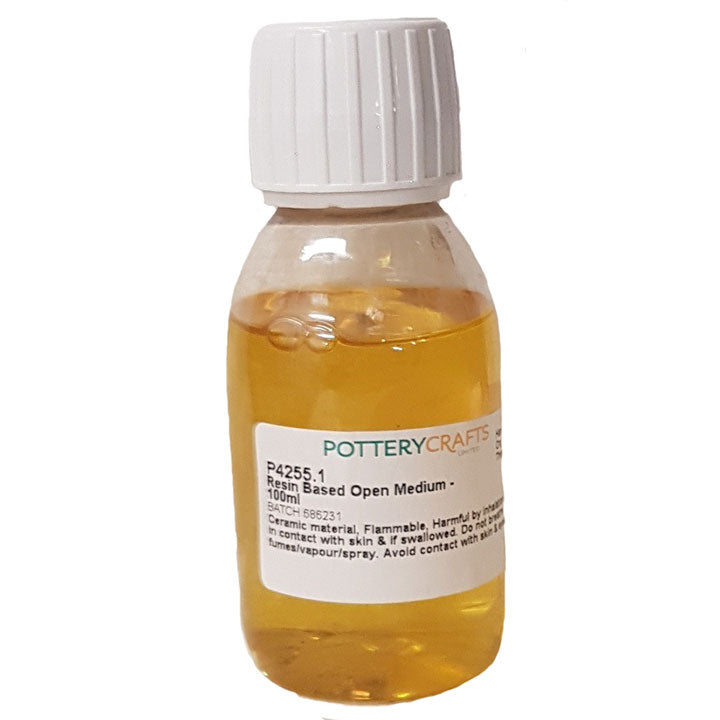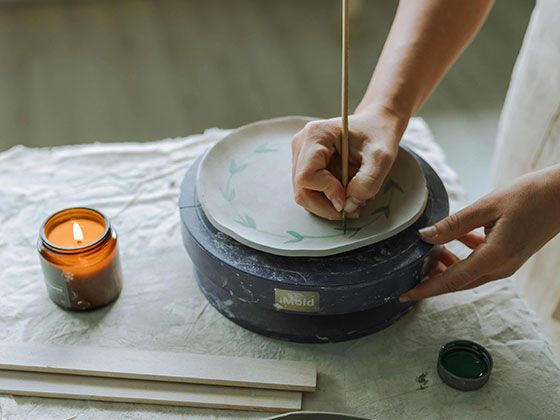

Potterycrafts Resin Based Open Medium
Resin based open medium for underglaze and on-glaze painting.
Underglaze requires hardening on before glazing.
Mix and blend together equal parts (by volume) of powder colour with P4264 medium.
Then further adjust to the consistency you require by adding more medium.
Cleaning Brushes:
Use either P4259 Thinners or P4261 Turpentine for brush cleaning.
Tips for on-glaze painting:
Cadmium reds and yellow:
These warm colours need to be applied more thickly and fired at a
slightly lower temperature, to 790C (maximum), with little or no soak.
This method is most relevant to P4288 Golden Yellow.
Outlines:
Outlines for designs can be traced or drawn free hand using a soft pencil
or fine marker pen. For a more permanent result, a pale brown or grey
on-glaze colour can be used with a fine brush or pen. This can then be
fired to give an outline which will not be lost after the first firing.
Outlines are best done on ware that has been de-greased with turpentine
and dried.
Matt colours:
On-glaze colours can be matted down with the addition of a matting
agent such as zincoxide. This should be mixed at approximately two parts colour to one part matting agent.
Metals and lustres:
When working with any metals or lustres,we recommend you use a
brush dedicated to those products. Do not wash your brush with soap
and water, as this may cause faults on your next application. Rinse used
brushes in theappropriate essence and then wrap the bristle in
aluminium foil. If necessary,soften your brush with essence before
working
.
For details of brushes available from Potterycrafts, please refer to our
tools, sponges and brush section.
ON-GLAZE COLOURS AVAILABLE FROM POTTERYCRAFTS
Potterycrafts on-glaze colours fall into 3 categories
LEADED - (low sol)based on lead frits
LEADFREE - contains no lead whatsoever
Remember in all cases it is your responsibility to have the finished ware tested by a competent organisation
Learn more
Underglaze requires hardening on before glazing.
Mix and blend together equal parts (by volume) of powder colour with P4264 medium.
Then further adjust to the consistency you require by adding more medium.
Cleaning Brushes:
Use either P4259 Thinners or P4261 Turpentine for brush cleaning.
Tips for on-glaze painting:
Cadmium reds and yellow:
These warm colours need to be applied more thickly and fired at a
slightly lower temperature, to 790C (maximum), with little or no soak.
This method is most relevant to P4288 Golden Yellow.
Outlines:
Outlines for designs can be traced or drawn free hand using a soft pencil
or fine marker pen. For a more permanent result, a pale brown or grey
on-glaze colour can be used with a fine brush or pen. This can then be
fired to give an outline which will not be lost after the first firing.
Outlines are best done on ware that has been de-greased with turpentine
and dried.
Matt colours:
On-glaze colours can be matted down with the addition of a matting
agent such as zincoxide. This should be mixed at approximately two parts colour to one part matting agent.
Metals and lustres:
When working with any metals or lustres,we recommend you use a
brush dedicated to those products. Do not wash your brush with soap
and water, as this may cause faults on your next application. Rinse used
brushes in theappropriate essence and then wrap the bristle in
aluminium foil. If necessary,soften your brush with essence before
working
.
For details of brushes available from Potterycrafts, please refer to our
tools, sponges and brush section.
ON-GLAZE COLOURS AVAILABLE FROM POTTERYCRAFTS
Potterycrafts on-glaze colours fall into 3 categories
LEADED - (low sol)based on lead frits
LEADFREE - contains no lead whatsoever
Remember in all cases it is your responsibility to have the finished ware tested by a competent organisation
Volume (ml)
Pickup available at Stoke-on-Trent
Usually ready in 5+ days
Potterycrafts Resin Based Open Medium
500
Stoke-on-Trent
Pickup available, usually ready in 5+ days
Campbell Road
Stoke-on-Trent ST4 4ET
United Kingdom
Description
Resin based open medium for underglaze and on-glaze painting.
Underglaze requires hardening on before glazing.
Mix and blend together equal parts (by volume) of powder colour with P4264 medium.
Then further adjust to the consistency you require by adding more medium.
Cleaning Brushes:
Use either P4259 Thinners or P4261 Turpentine for brush cleaning.
Tips for on-glaze painting:
Cadmium reds and yellow:
These warm colours need to be applied more thickly and fired at a
slightly lower temperature, to 790C (maximum), with little or no soak.
This method is most relevant to P4288 Golden Yellow.
Outlines:
Outlines for designs can be traced or drawn free hand using a soft pencil
or fine marker pen. For a more permanent result, a pale brown or grey
on-glaze colour can be used with a fine brush or pen. This can then be
fired to give an outline which will not be lost after the first firing.
Outlines are best done on ware that has been de-greased with turpentine
and dried.
Matt colours:
On-glaze colours can be matted down with the addition of a matting
agent such as zincoxide. This should be mixed at approximately two parts colour to one part matting agent.
Metals and lustres:
When working with any metals or lustres,we recommend you use a
brush dedicated to those products. Do not wash your brush with soap
and water, as this may cause faults on your next application. Rinse used
brushes in theappropriate essence and then wrap the bristle in
aluminium foil. If necessary,soften your brush with essence before
working
.
For details of brushes available from Potterycrafts, please refer to our
tools, sponges and brush section.
ON-GLAZE COLOURS AVAILABLE FROM POTTERYCRAFTS
Potterycrafts on-glaze colours fall into 3 categories
LEADED - (low sol)based on lead frits
LEADFREE - contains no lead whatsoever
Remember in all cases it is your responsibility to have the finished ware tested by a competent organisation
Underglaze requires hardening on before glazing.
Mix and blend together equal parts (by volume) of powder colour with P4264 medium.
Then further adjust to the consistency you require by adding more medium.
Cleaning Brushes:
Use either P4259 Thinners or P4261 Turpentine for brush cleaning.
Tips for on-glaze painting:
Cadmium reds and yellow:
These warm colours need to be applied more thickly and fired at a
slightly lower temperature, to 790C (maximum), with little or no soak.
This method is most relevant to P4288 Golden Yellow.
Outlines:
Outlines for designs can be traced or drawn free hand using a soft pencil
or fine marker pen. For a more permanent result, a pale brown or grey
on-glaze colour can be used with a fine brush or pen. This can then be
fired to give an outline which will not be lost after the first firing.
Outlines are best done on ware that has been de-greased with turpentine
and dried.
Matt colours:
On-glaze colours can be matted down with the addition of a matting
agent such as zincoxide. This should be mixed at approximately two parts colour to one part matting agent.
Metals and lustres:
When working with any metals or lustres,we recommend you use a
brush dedicated to those products. Do not wash your brush with soap
and water, as this may cause faults on your next application. Rinse used
brushes in theappropriate essence and then wrap the bristle in
aluminium foil. If necessary,soften your brush with essence before
working
.
For details of brushes available from Potterycrafts, please refer to our
tools, sponges and brush section.
ON-GLAZE COLOURS AVAILABLE FROM POTTERYCRAFTS
Potterycrafts on-glaze colours fall into 3 categories
LEADED - (low sol)based on lead frits
LEADFREE - contains no lead whatsoever
Remember in all cases it is your responsibility to have the finished ware tested by a competent organisation

- A potter and sculptors favourite place to shop for over 40 years. We have everything you need!
- A wide and relevant product range with fantastic stock availability!
- Our prices are transparent and competitive!
- Expert technical advice with every purchase!
“Pottery is not just about shaping clay, it's a dance between the hands and the earth, a symphony of creation.
“Pottery is not just about shaping clay, it's a dance between the hands and the earth, a symphony of creation.
“Pottery is not just about shaping clay, it's a dance between the hands and the earth, a symphony of creation.







